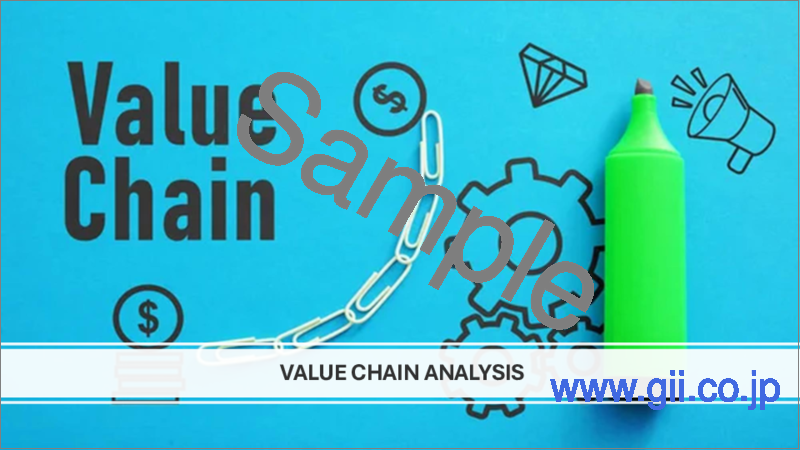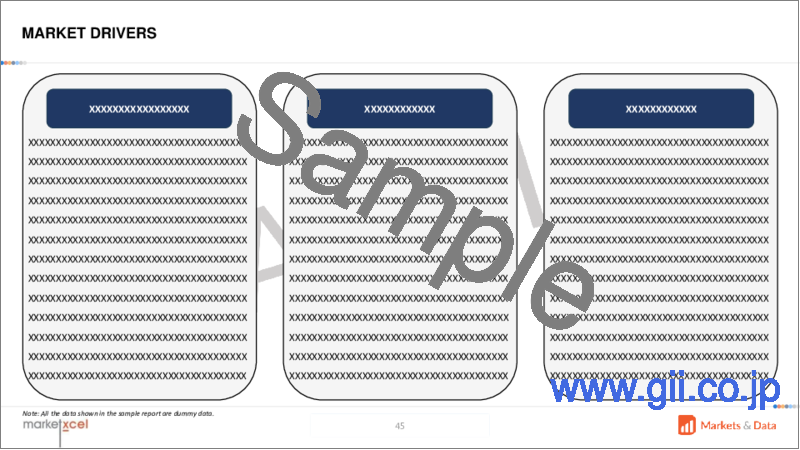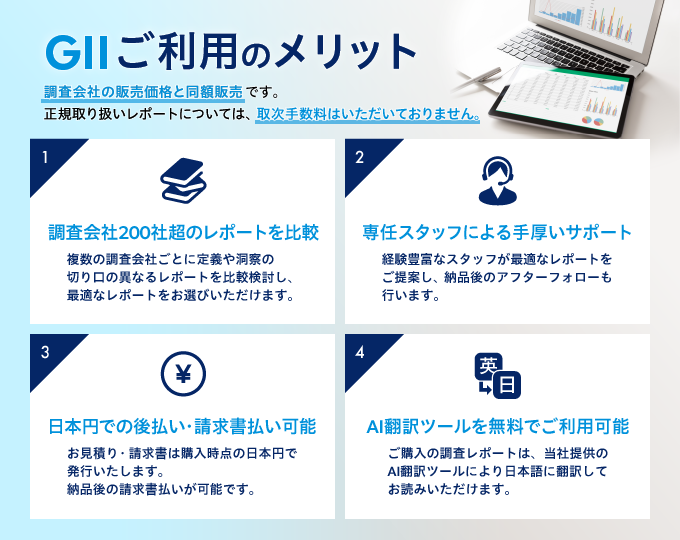|
|
市場調査レポート
商品コード
1635154
日本のラボグロウンダイヤモンド市場の評価:タイプ・技術・エンドユーザー・地域別の機会および予測 (2018-2032年)Japan Lab-Grown Diamonds Market Assessment, By Type, By Technology, By End-user, By Region, Opportunities and Forecast, FY2018-FY2032F |
||||||
カスタマイズ可能
|
|||||||
| 日本のラボグロウンダイヤモンド市場の評価:タイプ・技術・エンドユーザー・地域別の機会および予測 (2018-2032年) |
|
出版日: 2025年01月17日
発行: Markets & Data
ページ情報: 英文 126 Pages
納期: 3~5営業日
|
全表示
- 概要
- 図表
- 目次
日本のラボグロウンダイヤモンドの市場規模は、2024年の5億1,100万米ドルから、予測期間中は16.77%のCAGRで推移し、2032年には17億6,633万米ドルの規模に成長すると予測されています。同市場は近年著しい成長を遂げており、今後も堅調な拡大ペースを維持すると予想されています。
ラボグロウンダイヤモンドは、倫理的、環境的、経済的な理由から日本で重要性を増しています。従来のダイヤモンド採掘に伴う悪影響がないため、紛争がなく、環境的にも持続可能です。さらに、天然ダイヤモンドに比べてラボグロウンダイヤモンドは手頃な価格であるため、多くの消費者にとって非常に身近な存在となっています。若い世代の責任ある消費に対する社会的意識も、ラボグロウンダイヤモンドの需要に大きく寄与しています。これらのことから、日本のラボグロウンダイヤモンド市場は、日本の高級品部門における消費者の嗜好や価値観の変化を反映して、発展すると予測されています。
当レポートでは、日本のラボグロウンダイヤモンドの市場を調査し、市場の定義と概要、市場規模の推移・予測、各種区分別の詳細分析、産業構造、市場成長への影響因子の分析、ケーススタディ、競合情勢、主要企業のプロファイルなどをまとめています。
目次
第1章 プロジェクトの範囲と定義
第2章 調査手法
第3章 エグゼクティブサマリー
第4章 顧客の声
- 回答者の人口統計
- ブランド認知度
- 購入決定時に考慮される要素
第5章 日本の合成ダイヤモンド市場の展望
- 市場規模の分析・予測
- 市場シェアの分析・予測
- タイプ別
- 技術別
- エンドユーザー別
- 地域別
- 企業シェア分析 (上位5社およびその他)
- 市場マップ分析
第6章 需給分析
第7章 輸出入分析
第8章 バリューチェーン分析
第9章 ポーターのファイブフォース分析
第10章 PESTLE分析
第11章 市場力学
- 市場促進要因
- 市場の課題
第12章 市場の動向と発展
第13章 政策と規制状況
第14章 ケーススタディ
第15章 競合情勢
- 上位5社の競合マトリックス
- 上位9社の情勢
- CarbonLab Co. Ltd.
- Mokumeganeya Co., Ltd.
- Apple Green Diamond Inc.
- Pure Diamond Co., Ltd.
- LaBrilliante LLC
- PRMAL Inc.
- EDP Corporation
- Weiss Co., Ltd.
- Via Design Co., Ltd. (Next Diamond New York)
第16章 戦略的提言
第17章 当社について・免責事項
List of Tables
- Table 1. Pricing Analysis of Products from Key Players
- Table 2. Competition Matrix of Top 5 Market Leaders
- Table 3. Mergers & Acquisitions/ Joint Ventures (If Applicable)
- Table 4. About Us - Regions and Countries Where We Have Executed Client Projects
List of Figures
- Figure 1. Japan Lab-Grown Diamonds Market, By Value, In USD Million, FY2018-FY2032F
- Figure 2. Japan Lab-Grown Diamonds Market, By Volume, In Units, FY2018-FY2032F
- Figure 3. Japan Lab-Grown Diamonds Market Share (%), By Type, FY2018-FY2032F
- Figure 4. Japan Lab-Grown Diamonds Market Share (%), By Technology, FY2018-FY2032F
- Figure 5. Japan Lab-Grown Diamonds Market Share (%), By End-User, FY2018-FY2032F
- Figure 6. Japan Lab-Grown Diamonds Market Share (%), By Region, FY2018-FY2032F
- Figure 7. By Type Map-Market Size (USD Million) & Growth Rate (%), FY2024
- Figure 8. By Technology Map-Market Size (USD Million) & Growth Rate (%), FY2024
- Figure 9. By End-User Map-Market Size (USD Million) & Growth Rate (%), FY2024
- Figure 10. By Region Map-Market Size (USD Million) & Growth Rate (%), FY2024
Japan lab-grown diamonds market is expected to observe a CAGR of 16.77% during the forecast period FY2025-FY2032, rising from USD 511 million in FY2024 to USD 1766.33 billion in FY2032. The market has experienced significant growth in recent years and is expected to maintain a strong pace of expansion in the coming years.
Lab-grown diamonds are gaining high importance in Japan for ethical, environmental, and economic reasons. Since they do not possess the negative effects associated with traditional diamond mining, they are, therefore, conflict-free and environmentally sustainable. Furthermore, the affordability of lab-grown diamonds against natural diamonds makes them highly accessible to mass consumers. The social awareness about responsible consumption among younger generations also significantly contributes to the demand for lab-grown diamonds. Consequently, Japan lab-grown diamonds market is estimated to flourish, reflecting changes in consumer preferences and values in the country's luxury goods sector.
For instance, in September 2024, EDP Corporation, a Japanese firm specializing in lab-grown diamond production, acquired Lusix, an Israel-based lab-grown diamond company, for around USD 2.5 million. This deal marked a positive landmark for the expedition in Japan's growth rate of lab-grown diamonds. EDP's capabilities in making diamond seeds will increase the strength of local production capabilities and raise social awareness and innovation of lab-grown diamonds in the country. Moreover, Lusix's operations were retained by EDP Corporation to meet the increasing consumer demand for sustainable and ethically sourced diamonds in Japan.
Rapid Technological Advancements in Lab-Grown Diamonds Spearhead the Market Expedition
Synthetic diamonds are a technological breakthrough in Japan's lab-grown diamond industry. Japan has shown remarkable improvements in quality and affordability, making lab-grown diamonds almost indistinguishable from natural ones. These advancements improve the clarity of the diamonds and promote sustainable practices by reducing environmental impact. As consumer demand for ethical products grows, Japan's leadership in synthetic diamond technology positions it to meet consumers' preferences and fuel growth and innovation in the market.
For instance, in September 2024, Japan's Saga University created a breakthrough in the application of synthetic diamonds for power semiconductors, where the diamonds exhibited remarkable properties, such as having 33 times the electrical strength and five times the thermal tolerance compared to silicon. The advancement positioned synthetic diamonds as the next best alternative for future semiconductors with potential applications in electric vehicles and charging stations. The most recent examples are the world's first use of a power circuit based on diamond semiconductors and the high-volume production of large-size diamond wafers by companies such as Orbray Co. Ltd located in Tokyo. The commercialization of this technology marked a transformative shift in the country's semiconductor materials.
Utilization of Lab-Grown Diamonds in the Automotive Industry Augments Market Growth
Lab-grown diamonds are significant to Japan's automotive industry as they are characterized by some unique properties and sustainability advantages. Lab-grown diamonds formed via advanced techniques such as Chemical Vapor Deposition (CVD) and High-Pressure High Temperature (HPHT) possess remarkable hardness and thermal conductivity, making them suitable for applications in cutting tools, machinery components, etc. Moreover, the lab-grown diamonds perfectly align with the shift of the country's automotive sector towards eco-friendly practices as they reduce dependence on mined resources.
Additionally, lab-grown diamonds' cost-effectiveness and ethical appeal resonate with an increasing consumer base that values sustainability. As much as integrating lab-grown diamonds enhances the performance of automobiles, it represents supporting innovation and environmental commitment. This improves product performance and supports innovation and environmental responsibility in a way that makes the country stand at the forefront of sustainable material utilization within the automotive industry. The trend thus represents one step in a larger approach of integrating advanced materials within industries, pointing to the ability of lab-grown diamonds to greatly transform the automotive sector of Japan and yield substantial market growth in the future.
The Advent of Colored Lab-Grown Diamonds is Expediting the Market Prospects
The emergence of colored lab-grown diamonds is expected to accelerate the growth rate of the market exponentially. As today's conscious consumers are concerned about the detrimental consequences that traditional diamonds sourced from mines can have, colored lab-grown diamonds are becoming a preferable choice among customers due to their ethically sourced nature and call for environmental sustainability. The possibility of producing all sorts of colors through controlled processes allows for customization toward different consumer preferences. Moreover, colored synthetic, lab-grown diamonds are relatively cheaper than natural stones, making them affordable for a larger number of consumers, thus driving demand and creating an expansion in Japan's jewelry. Moreover, Japanese companies focus on campaigns and events abroad for lab-grown diamonds to promote the brands, educate consumers on ethical and sustainable practices, and capitalize on international markets.
For instance, in November 2024, Japan's First Lab-grown diamond jewelry brand, SHINCA (marketed by Imayo & Co., Ltd), announced its first pop-up event in Singapore. The pop-up event featured a wide variety of colored lab-grown diamond rings, highlighting the vibrant color options available in the store. With the availability of a variety of colors that mirror current trends in sustainable jewelry design, the event undeniably paved the way for improved customer experience and awareness of lab-grown diamonds.
Southern Japan Emerged as the Market Leader
The southern region of Japan has significantly dominated the market and is expected to continue to do so in the coming years. This is owing to higher consumer consciousness of sustainable, ethical values and development in production techniques of lab-grown diamonds via CVD, which increases the quality of cultured diamonds and makes them much more affordable. Local manufacturers also actively promote the products using innovative marketing strategies, making them highly visible. Moreover, businesses and research institutions have been working in collaboration with each other for the advancement of lab-grown diamonds, thereby positioning Southern Japan as the largest hub for lab-grown diamonds in the country.
Furthermore, Kyushu emerged as the most prominent region of southern Japan. This region is recognized for its blend of traditional craftsmanship and innovative industries and is fostering an emergent demand for lab-grown diamond products. Additionally, local manufacturers and retailers actively promoting these diamonds contribute to Kyushu's strong market position, thus positing the southern region as a major hub in Japan for the lab-grown diamond industry.
Future Market Scenario (FY2025 - FY2032F)
While traditional diamonds have deep cultural value in Japan, the growing acceptance of lab-grown diamonds is a clear indication that consumer attitudes are changing. The interplay between established luxury perceptions and emerging demand for sustainable options creates a dynamic market environment that will likely continue with the evolving changes in consumer preferences.
Innovations in lab-grown diamond production technologies, including Chemical Vapor Deposition (CVD) and High Pressure and High Temperature (HPHT), are improving the quality and variety of lab-grown diamonds available in Japan. These innovations have made it possible to create diamonds that are comparable in beauty and durability to natural stones while reducing production costs, thus making them more accessible to consumers, which in turn, will cater to ample opportunities for growth over the upcoming years.
Japan lab-grown diamonds market is rapidly becoming competitive owing to the growing influx of domestic and international players being involved in the lab-grown diamond business. Key players from both regions will use appropriate marketing strategies with advanced features on lab-grown diamonds to increase sales in a progressively changeable marketplace and consequently lead to ample scopes of expansion in the times ahead.
Key Players Landscape and Outlook
Market leaders in Japan lab-grown diamond industry are adopting crucial strategies to enhance their market penetration and competitiveness. Key strategies include product development mergers and acquisitions, etc. with a strong focus on innovative lab-grown diamonds that meet stringent consumer demands. The country is also exploring new technologies to improve production efficiency and quality. Furthermore, companies are diversifying their activities to expand into new markets and create additional revenue streams. This proactive approach positions Japanese firms to capitalize on the growing global demand for ethical and sustainable alternatives to mined diamonds, driving significant growth in the industry.
In March 2023, Mokumeganeya Co.Ltd. announced incorporating International Gemological Institute (IGI) certified lab-grown diamonds into its offerings, blending modern technology with artisanal craftsmanship. Diamonds that pass IGI's grading standards are recognized for their superior quality, making them appealing to consumers seeking ethical and sustainable alternatives to mined diamonds. Thus, they enhance market growth in Japan's luxury sector.
Table of Contents
1. Project Scope and Definitions
2. Research Methodology
3. Executive Summary
4. Voice of Customer
- 4.1. Respondent Demographics
- 4.2. Brand Awareness
- 4.3. Factors Considered in Purchase Decisions
5. Japan Lab-Grown Diamonds Market Outlook, FY2018-FY2032F
- 5.1. Market Size Analysis & Forecast
- 5.1.1. By Value
- 5.1.2. By Volume
- 5.2. Market Share Analysis & Forecast
- 5.2.1. By Type
- 5.2.1.1. Colored
- 5.2.1.2. Colorless
- 5.2.2. By Technology
- 5.2.2.1. Chemical Vapor Deposition (CVD)
- 5.2.2.2. High Pressure and High Temperature (HPHT)
- 5.2.3. By End-user
- 5.2.3.1. Jewelry and Fashion Industry
- 5.2.3.2. Electronics and Semiconductor Industry
- 5.2.3.3. Automotive Industry
- 5.2.4. By Region
- 5.2.4.1. North [Hokkaido and Tohoku]
- 5.2.4.2. Central [Kanto and Chubu]
- 5.2.4.3. South [Kansai, Chugoku, Shikoku, and Kyushu & Okinawa]
- 5.2.5. By Company Market Share Analysis (Top 5 Companies and Others - By Value, FY2024)
- 5.2.1. By Type
- 5.3. Market Map Analysis, FY2024
- 5.3.1. By Type
- 5.3.2. By Technology
- 5.3.3. By End-user
- 5.3.4. By Region
6. Demand and Supply Analysis
7. Import Export Analysis
8. Value Chain Analysis
9. Porter's Five Forces Analysis
10. PESTLE Analysis
11. Market Dynamics
- 11.1. Market Drivers
- 11.2. Market Challenges
12. Market Trends and Developments
13. Policy and Regulatory Landscape
14. Case Studies
15. Competitive Landscape
- 15.1. Competition Matrix of Top 5 Market Leaders
- 15.2. Key Players Landscape for Top 9 Market Players
- 15.2.1. CarbonLab Co. Ltd.
- 15.2.1.1. Company Details
- 15.2.1.2. Key Management Personnel
- 15.2.1.3. Key Products Offered
- 15.2.1.4. Key Financials (As Reported)
- 15.2.1.5. Key Market Focus and Geographical Presence
- 15.2.1.6. Recent Developments/Collaborations/Partnerships/Mergers and Acquisition
- 15.2.1.7. SWOT Analysis for Top 5 Players
- 15.2.2. Mokumeganeya Co., Ltd.
- 15.2.3. Apple Green Diamond Inc.
- 15.2.4. Pure Diamond Co., Ltd.
- 15.2.5. LaBrilliante LLC
- 15.2.6. PRMAL Inc.
- 15.2.7. EDP Corporation
- 15.2.8. Weiss Co., Ltd.
- 15.2.9. Via Design Co., Ltd. (Next Diamond New York)
- 15.2.1. CarbonLab Co. Ltd.
Companies mentioned above DO NOT hold any order as per market share and can be changed as per information available during research work.





